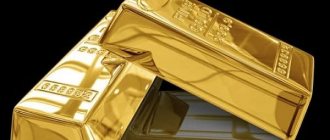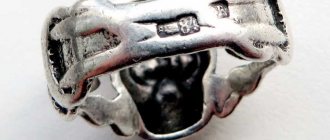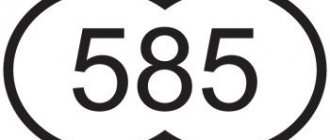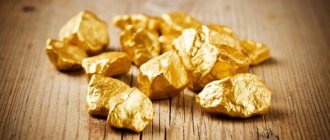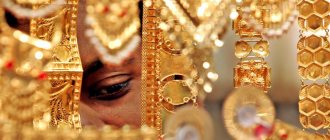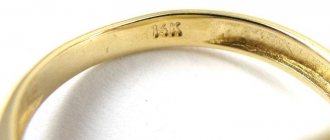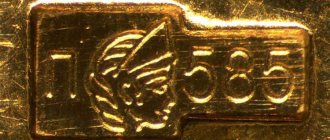The issue of large denomination gold coins was of particular importance for the sovereigns of Russia. From the 15th to the 17th centuries. these coins more often became rewards than means of payment. Or they were still used for payments, but only for international ones. Only since the 18th century. There is a need for such money in the country’s domestic market.
A coin made of “royal metal” emphasized the strength and independence of royal power, the sustainability of economic growth and encouraged foreign merchants to cooperate.
Russian gold coins: the beginning
“Chervonets” have long been the name for foreign and Russian large denomination coins containing high-grade gold.
Stable production of such copies in Russia began under Emperor Ivan III (second half of the 15th century). At the same time, the first gold coin of Russian coinage - the “zlatnik” of the Kyiv prince Vladimir - was issued five centuries earlier.
Its official name is unknown. The minting of zlatnik was important from a political point of view: during this period, Kyiv asserted its importance and established new relations with neighboring states. Under Prince Vladimir, the country did not have its own gold; instead of Russian coins, they paid with Byzantine or Arab ones.
The solidus of the Byzantine emperor, a rival whom the Kiev prince looked up to, was taken as a model for coinage. Both coins are similar in weight, gold purity and images on the obverse and reverse.
11 known examples of this issue were found in treasures discovered in the 19th century. Ten of them are in museum collections; it is unknown who owns the eleventh. Modern collectors can purchase a zlatnik in the form of a commemorative gold copy, issued in honor of the millennium of ancient Russian coinage (denomination 100 rubles, edition 1988).
Proof of status
Issues of small circulations of gold coins under Ivan III are explained by almost the same reasons as under Prince Vladimir. The Emperor unites the Russian lands, destroys the Tatar-Mongol yoke, and streamlines the laws. The Byzantine double-headed eagle had already become Moscow's; the Grand Duke had a different goal during this period: to prove the equality of Russia and its European neighbors.
During this period, English and Hungarian coins (“shipman” and “Ugric” gold) were used as models for minting. In addition to these foreign gold coins, Venetian and Dutch ducats circulated in Muscovite Rus'. The word “Ugric” was used to describe both Russian and foreign coins: this definition indicated the purity of the metal. The state still had not established industrial gold mining, so new Russian editions were minted from melted down foreign ones.
It is possible that Moscow gold was sometimes used to pay, for example, specialists invited from abroad. However, they were usually intended for rewards and gifts. A hole or ear was made on such a granted coin to be worn around the neck or hung on an icon. You can now see these gold ones in the museum.
Until the end of the 17th century, the rulers of Russia, following Ivan III, minted gold coins with their portrait and a double-headed eagle.
Origin of the name "chervonets"
The word “chervonets” was formed from the phrase “chervonets gold”: an alloy of copper and gold was used for minting. The result of combining metals corresponded to samples from 916 to 986. Even a small amount of copper in the alloy gives a reddish tint, so the color of such gold was designated by the word “red” (after the method of extracting red dye from the cochineal mealybug).
The official name “chervonets” during Soviet times was used for a new monetary unit, equal in gold content to a ten-ruble coin with a portrait of Nicholas II. Therefore, in recent decades, this word has often been used to refer to coins and banknotes in denominations of 10 rubles or anything in the amount of ten.
On chervonets issued before the 18th century, the denomination was not indicated: when calculated, they corresponded to silver rubles (from 1 ruble 20 kopecks to 3 rubles 50 kopecks in different periods).
The cost of royal chervonets today
If we talk about the cost of the royal gold chervonets, then it is necessary to take into account the year the coin was minted and its other characteristics.
Expert opinion
Sidorenko Alexander
Antiques appraiser, numismatist
During the time of Nicholas II, various banknotes were produced, their price can be equal to the actual cost of gold. And it can reach 25 thousand dollars and above. An example is the 1906 chervonets.
In any case, it is worth considering a coin from the reign of the last emperor as an antique. If its authenticity is confirmed by a certificate (without it, sale is impossible), then the cost of the unit will be determined by the auction staff.
Numismatists prefer not to sell old coins unnecessarily, since their price only increases every year.
Chervontsi of the 17th century
After the Time of Troubles, the Romanov dynasty came to power in 1613. Before the monetary reform of Peter I, rulers minted award coins of a whole chervonets, part of it, or several chervonets.
From 1613 to 1682, both sides of such specimens were decorated with double-headed eagles; under Princess Sophia, there were portraits of Tsars John, Peter and their sister-regent. The traditional name “Ugric” was assigned to these coins (this is how they are called in modern numismatics).
The year of minting began to be indicated under Peter I (first in letters of the alphabet, then in Arabic numerals).
The connection of historical times is clearly visible on the double “Ugric” of Alexei Mikhailovich: the images on its sides in general repeat the golden prince Vladimir or the Byzantine solidus. Perhaps the appearance of such a chervonets is connected with the tsar’s plans to become the sole trustee of the universal Orthodox Church. One of two known copies of the coin is kept in the Hermitage.
Story
The gold ten of 1901 issue appeared thanks to the monetary reforms of Yu. Witte. In order to improve the economic situation of the state, the Minister of Finance introduced the backing of the ruble in gold.
Without detracting from the dignity of the coin, it should still be said that this is just a two-centimeter gold circle. In pre-revolutionary Russia, it was a common banknote for payments between buyers. It was freely exchanged for paper money and vice versa. Historians claim that the Russians were not very fond of them because of their small size and the inconvenience associated with them. Ask yourself which is easier to lose: a small gold round or a large paper bill, and the answer will become obvious.
But hiding treasures with “royal chervonets” was very convenient. This is probably the reason for the numerous stories and legends about treasures, inherited wealth and criminal crimes associated with this coin.
The gold tenth originally weighed 12.9 grams and was pegged to silver. With the appearance in circulation of the gold chervonets of Nicholas II of 1901, 10 rubles were equated to pure gold weighing 7.8 grams (rounded).
Chervontsi of Peter I
The transformations of Peter the Great required the renewal of a dilapidated economic system, the crisis of which in the middle of the 17th century had already led to several popular unrest.
In 1701, coins of one and two chervonets were issued, modeled after the Dutch ducats. Unlike previous issues, Peter I's chervonets were intended not only for the purchase of goods abroad, but also for payments within the country. Gold sand for minting was purchased in China. At the same time, active development of precious metal deposits in Russia begins.
The chervonets of 1701 was made from 969 standard metal. It contained 3.36 g of gold and weighed 3.47 g (double chervonets - 6.94 g). It was distinguished from the ducat by Russian inscriptions (however, on the copy of 1716, intended for the Tsar’s trip to Europe, inscriptions were minted in Latin).
Chervonets, issued from 1701 to 1718, were distinguished by many small details, however, the main images were repeated: on the obverse - a portrait of the sovereign with a laurel wreath on his head (a symbol of triumph, the immortality of power), on the reverse - a double-headed eagle. The cost of these coins, which did not have a specified denomination, was determined by gold prices and did not exceed 2 rubles. 30 kopecks silver
Chervonets with a portrait of Peter I were in circulation before the reform of Anna Ioannovna.
Chervonets 1706
This coin is interesting because the year of minting on its reverse is indicated in letters of the Old Russian alphabet. The exact number of surviving copies has not been established.
Two-ruble chervonets
The need to replenish the treasury led to changes in the rules for minting chervonets. From 1718 to 1728, coins with the indicated denomination of 2 rubles were issued in Russia. For their production, gold of a lower standard was used than in chervonets of previous years (781 samples). It was obtained from melted down foreign coins. This gold coin received the name “Andreevsky” because of the design depicting the Apostle Andrew on the reverse instead of a coat of arms. It weighed 4.1 g - more than a chervonets without a denomination.
Two-ruble chervonets with a portrait of the ruling person were minted until the reign of Peter II, when they were recognized as unprofitable and inconvenient. Mints have again begun producing gold coins without a specified denomination.
Due to the peculiarities of minting, two-ruble chervonets of the same edition often differ from each other.
“Andreevskie Novodelnye” and more
It is interesting that the minting of two-ruble chervonets or coins with portraits of late rulers did not stop completely - a modern collector can get into the hands of even a copy from 1890. The remakes were made according to private orders; they participated in exhibitions organized by the government. Such releases were prohibited by decree of Alexander III.
An examination conducted by a specialist will help to distinguish a real chervonets, for example, 1718-1728, from its later counterparts.
Degree of preservation
You cannot sell or buy a thing without assessing its condition; this rule also applies to coins. There are several degrees of preservation, the assessment is given by an employee of an auction or numismatic store. The following markings are considered generally accepted:
- VG. – indicates that the sign is heavily worn, the embossing is barely visible, the degree of wear is estimated at 50%. Such coins are relatively inexpensive.
- VF. – the specimen has abrasions and minor gouges, protruding parts of the design are smoothed out, the degree of wear does not exceed 75%.
- XF. – coins with this level of wear do not shine, small relief is difficult to discern, changes are visible to the naked eye, but the general condition of the mark is assessed as satisfactory.
- AU. – specimens have a shine, but smoothing of large details is acceptable; abrasions are barely noticeable.
- UNC. – only those specimens that are not damaged receive such an assessment. Small and large details are visible, the chervonets shines, it is cleaned and polished. But patina-covered signs are more valuable.
Dutch Russian ducats
Under Anna Ioannovna, a secret semi-legal minting of chervonets, identical to Dutch ducats, was founded in Russia. The production of these coins, nicknamed "lobanchiki" or "arapchiki", continued until the official protest of the Netherlands in 1869.
The economy of the Russian Empire required easily recognizable coins that would inspire confidence abroad. Ducats, whose appearance had not changed for many centuries, were perfect for this role. The manufactured counterfeits played a major role in Russia's international trade and facilitated the supply of military campaigns outside the country.
Regular and double: golden chervonets of Peter's daughter
During the reign of Elizabeth, ordinary chervonets were mostly minted, but in 1749 double circulations were issued. Under the empress, other large denomination gold coins appeared:
- 2 rubles;
- 5 rubles (“half-imperial”);
- 10 rubles (“imperial”).
The imperial and semi-imperial were intended for use within the country, and the chervonets (regular and double) were for foreign trade.
It is worth noting that the image of the Apostle Andrew briefly returned to the chervonets in 1749 (in addition to the regular and double chervonets, the same “Andreev’s” ones were minted in these years).
Where to sell?
The transaction has pros and cons and is carried out on various platforms. We are talking not only about shops and antique shops, but also about online auctions, which are often conducted by numismatists. Please note that some stores reduce the cost of a currency unit by 20%.
Having in your hands an original coin from the reign of the last emperor of the Romanov dynasty, you should not rush to sell it. If you need to raise money as soon as possible, then it is better to show the sign to several appraisers, and only then make a decision about putting the lot up for auction.
Chervontsi on the eve of the revolution
After Paul I, only counterfeit Dutch ducats continued to be issued in Russia from coins that were called “chervonets” and had no denomination.
Under Nicholas I, to reduce platinum reserves in the treasury, platinum chervonets were minted for some time. Gold coins began to play an important role in the country’s domestic market only towards the end of the 19th century.
Fifteen turned into ten
During the 19th century. The Russian economy failed to overcome the discrepancy in the value of paper and metal money. By the end of the century it was necessary to reform the monetary system.
After the reform of Minister S.Yu. Witte's main monetary unit could have been bimetallic coins. However, their stability was questioned, and the new specimens, released in 1895-97, were made of 900 gold.
The new coins received the old name - imperial and semi-imperial, but their denomination was increased to 15 and 7.5 rubles. The Nicholas Imperial corresponded to the ten-ruble imperial of Alexander III. On the obverse of the chervonets there was a portrait of the sovereign.
The circulations were large (sometimes issues were even ordered abroad), so the value of many Nikolaev chervonets is now estimated only by the precious metal content in them.
The last issue of chervonets under Nicholas II dates back to 1911. However, a century later, there are hundreds of times more coins from this year of issue than indicated in official documents. Probably, during the revolution and after it, chervonets were minted underground.
Coin Rus
Trial copies of the new monetary unit “Rus” were issued in 1895. The denomination of the coin was ⅓, ⅔ and one imperial. However, the new name was never used, and proof copies are now owned by museums and private collections.
Russian 100 francs
The collector's coin was issued in 1902 (900 gold, mintage 235-236 copies). On its reverse there are both Russian (37.50 rubles) and French (100 francs) denominations. Perhaps this circulation was going to be used to strengthen diplomatic relations with France. All copies released in 1902 were presented to the Tsar's relatives.
Coronation Jubilee 1906
Chervonets of Nicholas II, issued in an edition of 10 copies in 1906, is one of the most expensive Russian coins. This was probably a test mint in preparation for the coronation anniversary.
The cost of coins depends on their authenticity, age, condition, size and characteristics of the circulation, and the number of surviving copies. “Royal Metal” lives up to its name: some chervonets are so rare that they can only be seen in a museum. Such coins stand out from the rest due to their quality and release features and, despite their high cost, attract the attention of most collectors.
How to spot a fake
10 rubles of 1901 made of gold due to its price and popularity attracts many counterfeiters. Cases of counterfeiting are quite common in this environment, which makes it urgent to correctly distinguish the original from all kinds of fakes.
The low price for a sold sample should be the first thing to worry about. The owner of a real coin will never give it away for nothing. Here the conclusion is clear: fake or criminal (stolen).
A high price is also not a guarantee of authenticity. They may deliberately inflate the price in order to reduce vigilance, and then make a concession during the bargaining process and sell the buyer a fake.
When purchasing a coin, you should be careful and check in every possible way. It should be noted that there are no universal ways to distinguish a fake from an original.
You can give only a few tips for independently analyzing the chervonets, but it is better to contact experienced numismatists:
- know the historical period of coin issue. For example, the image of an eagle must correspond to that year's national emblem;
- check "to the teeth". Determine the degree of metal hardness. Gold is a soft metal and can easily leave marks. Do not forget that a fake may be made of lead;
- magnetic properties. Gold has no magnetic properties;
- foreign metal. It is possible that the coin is gold plated. By slightly scratching the sample with a needle, it is easy to recognize a fake;
- nature of the surface. A perfectly smooth surface should raise suspicions. Having passed through decades, the chervonets cannot look perfect, especially from circulation;
- inspection of the herd. The initials of the mintzmeister must coincide with the officials who actually worked that year;
- specifications. The coin must correspond to the weight and diameter of that year of minting;
- detailed inspection of the stamp. Minting is a very labor-intensive process; counterfeits are usually cast. Such fakes will have small tubercles, drops of metal on the surface of the workpiece, easily distinguishable with a magnifying glass.
There are, of course, exemplary fakes that can mislead even experts, but such cases are very rare. If such a copy somehow ends up in the collection, do not be upset. A talented fake is also a rarity, which sometimes costs significant money.
